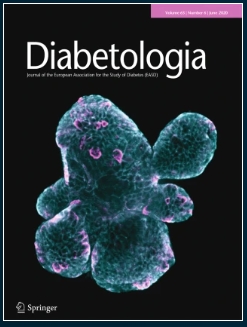胎盘mTOR信号与小鼠线粒体功能障碍、营养转运和新生儿β细胞扰动有关。
IF 10.2
1区 医学
Q1 ENDOCRINOLOGY & METABOLISM
引用次数: 0
摘要
目的/假设胎儿代谢健康的编程受子宫内环境的影响。胎盘营养传感器靶雷帕霉素(mTOR)参与调节胎儿生长和后代代谢健康,但其机制尚不清楚。方法采用胎盘mTOR缺乏模型诱导胎儿生长受限(FGR),研究mTOR调节胎盘线粒体功能、营养转运和胰腺β细胞的发育程序,胰腺β细胞对子宫内营养水平非常敏感。结果我们发现mTOR基因敲除(mTORKO)小鼠胎盘线粒体功能和形态存在缺陷。尽管两性胎盘和FGR都较小,但营养转运蛋白表达和亮氨酸通量在女性mTORKO胎盘中矛盾地增加。暴露于胎盘mTOR缺乏症(mTORKOpl)的女性胎儿表现出明显的循环胰岛素减少,而新生儿胰岛素分泌不受干扰。然而,mTORKOpl女性胎儿的平均β细胞大小和增殖增加,可能是由系统A (SNAT)氨基酸驱动的,表明未成熟的β细胞表型。成年mTORKOpl雌性后代表现出对饮食引起的肥胖、胰岛素抵抗和对高营养环境无法产生β细胞群反应的易感性。结论/解释:我们新的胎盘mtor直接驱动FGR的体内模型提供了强有力的证据,证明胎盘功能障碍和氨基酸运输与生命早期β细胞的适当编程有关。本文章由计算机程序翻译,如有差异,请以英文原文为准。
Placental mTOR signalling links mitochondrial dysfunction, nutrient transport and neonatal beta cell perturbations in mice.
AIMS/HYPOTHESIS
Fetal programming of metabolic health is influenced by the in utero environment. The placental nutrient sensor mechanistic target of rapamycin (mTOR) is implicated in regulating fetal growth and programming of offspring metabolic health, but the mechanisms are unknown.
METHODS
Using a placental mTOR deficiency model to induce fetal growth restriction (FGR), we investigated mTOR-modulated placental mitochondrial function, nutrient transport and developmental programming of pancreatic beta cells, which are exquisitely sensitive to nutrient levels in utero.
RESULTS
We found defects in placental mitochondria function and morphology that were specific to placentas of mTOR knockout (mTORKO) mice. Despite smaller placentas and FGR in both sexes, nutrient transporter expression and leucine flux were paradoxically increased in female mTORKO placentas. Female fetuses exposed to placental mTOR deficiency (mTORKOpl) displayed significantly reduced circulating insulin without neonatal perturbations in insulin secretion. However, average beta cell size and proliferation were increased in mTORKOpl female fetuses, possibly driven by system A (SNAT) amino acids, suggesting an immature beta cell phenotype. Adult mTORKOpl female offspring exhibit increased susceptibility to diet-induced obesity, insulin resistance and inability to mount a beta cell mass response to a hypernutrient environment.
CONCLUSIONS/INTERPRETATION
Our novel in vivo model of direct placental mTOR-driven FGR provides strong evidence linking placental dysfunction and amino acid transport to proper programming of beta cells in early life.
求助全文
通过发布文献求助,成功后即可免费获取论文全文。
去求助
来源期刊

Diabetologia
医学-内分泌学与代谢
CiteScore
18.10
自引率
2.40%
发文量
193
审稿时长
1 months
期刊介绍:
Diabetologia, the authoritative journal dedicated to diabetes research, holds high visibility through society membership, libraries, and social media. As the official journal of the European Association for the Study of Diabetes, it is ranked in the top quartile of the 2019 JCR Impact Factors in the Endocrinology & Metabolism category. The journal boasts dedicated and expert editorial teams committed to supporting authors throughout the peer review process.
 求助内容:
求助内容: 应助结果提醒方式:
应助结果提醒方式:


